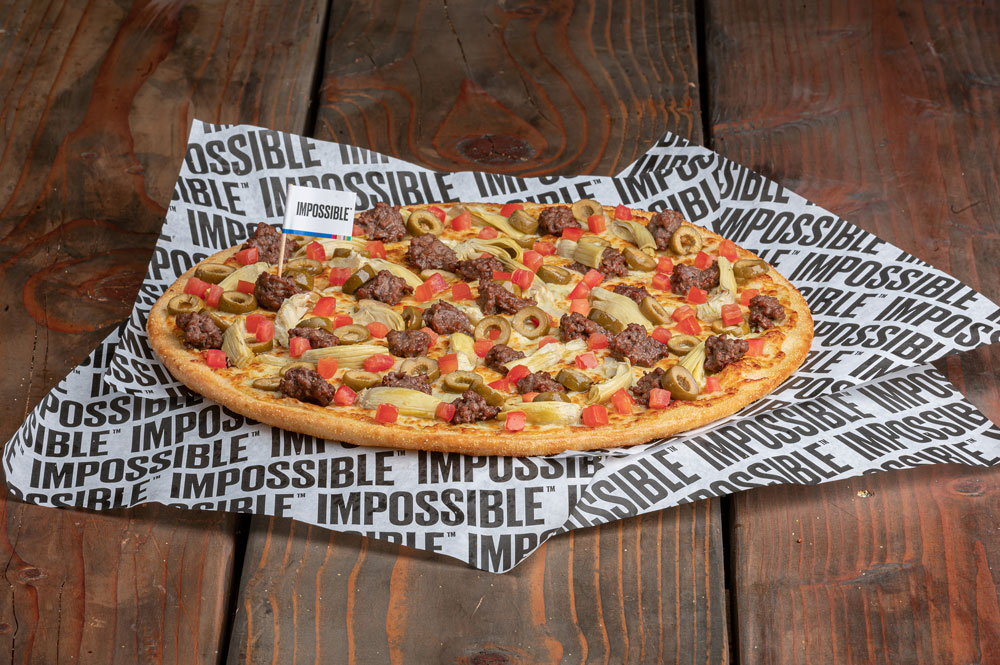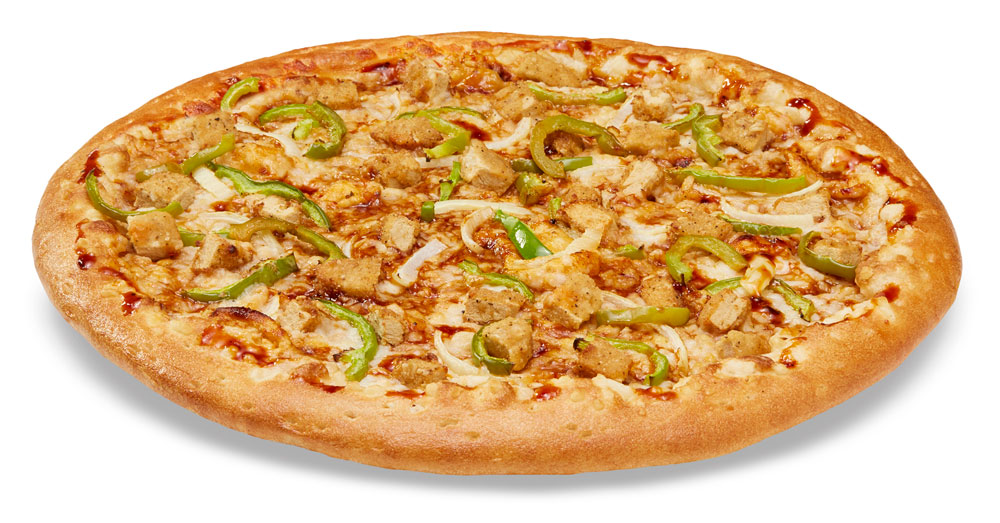- Today’s manufacturers are increasingly creating plant-based protein alternatives that taste great and satisfy demands for quality nutrition, cleaner labels and even sustainable sourcing.
- But it’s important to understand their exact flavor profiles and experiment in pairing them with existing toppings to come up with the perfect pizza combinations
Related: Get the latest vegan pizza news, products and recipes on PizzaVegan.com!
By Tracy Morin
Rising consumer awareness of environmental concerns, the spread of a worldwide pandemic, a greater focus on personal health and wellness—so many influences have combined to transform vegetarian, vegan and plant-based eating from borderline outlandish to widely embraced. And experts predict this growth will only continue. Last March, Dublin-based Research and Markets reported that “the global market for plant-based meat, estimated at $13.6 billion in the year 2020, is projected to reach a revised size of $35 billion by 2027.” (Editor’s update: As of September 2023, the World Animal Foundation predicted that the global plant-based meat market will reach $18.41 billion by 2030.) Perhaps future generations will altogether ditch the notion of protein alternatives being, well, alternative.

Pizza Guys got its plant-based foot in the door by partnering with a well-known national brand.
Demographics and Demands
According to Trevor Hitch, founder and CEO of VEDGEco in Kailua, Hawaii, as many as 6% of U.S. customers now claim the “vegan” label, a 500% increase over the 1% reported in 2014. However, it’s worthwhile to note that many plant-based alternatives are actually designed to appeal to carnivores looking to cut their meat consumption.
This move away from meat is taking hold worldwide. Tommy Leung, owner of Gafell, a Hong Kong-based maker of frozen pizzas and meals, says his customers love the chance to go meatless, thanks to today’s easy replacements. “I would say the majority are not vegan or even vegetarian,” Leung says. “It’s mostly meat eaters that are looking for green alternatives—flexitarians who are looking to cut down.” And Hitch adds that more than one-third of the U.S. population now fits this category.
“I would recommend taking advantage of co-branding with one of the top brands producing plant-based products to help get through to the customer. Operators should also come up with new recipes to create more buzz.”
— Reza Kamalian, Pizza Guys
Accordingly, even pizza chains are hopping on the plant-based bandwagon. Toppers Pizza, based in Whitewater, Wisconsin, with 69 stores in 12 states, unveiled its new vegan-friendly menu in late 2020. “Plant-based toppings are growing rapidly in the pizza category—we follow Technomic’s reporting closely, and four of the top 10 fastest growing ingredients are plant-based,” explains Mac Malchow, director of national marketing and menu innovation for Toppers Pizza. “What used to be solely beef in the plant-based world has grown to nearly all proteins. Plant-based pork, chicken and cheese are all rising in popularity, as more and more customers are choosing alternative diets and lifestyles. Most independent and regional chains, including Toppers Pizza, have begun incorporating multiple plant-based toppings into their menus in just the last couple of years—and customers are responding well with their dollars and social engagement.”
So many consumers making the switch to plant-based naturally leads to positive environmental impacts, but there’s another benefit to note: As demand for plant-based food grows, so does competition—and that leads to ever more innovation. In this competitive market, if brands don’t nail top-notch taste and texture, they’re toast, so the bar constantly raises. Today’s manufacturers are increasingly creating protein alternatives that not only taste great but satisfy demands for quality nutrition, cleaner labels and even sustainable sourcing. And, considering how relatively young this movement is, one can only imagine the sky-high potential for future developments.
Related: Vedgeco is first nationwide wholesaler of plant-based foods for restaurants

Toppers Pizza worked with a vegan chef and restaurant owner to create its plant-based pizza menu.
Prepping and Pairing
Many chefs have been surprised at the ease and performance of plant-based proteins. When Leung first tested alternative meats from one popular brand, he remembers being blown away. “We had heard all the stories about how it’s supposed to taste just like meat and even bleed when you cook it—needless to say, we were quite skeptical,” he recalls. “But it was true! Even better for us was that we didn’t have to make any big changes to our recipes. Since the [plant-based] meat behaves so much like minced beef, we simply replaced it 1:1, and the results were fantastic.”
Using the new protein, Leung first experimented with making plant-based versions of lasagna bolognese and savory pies, then moved on to pizzas, which soon sold out. “Our customers loved it,” Leung reports. “One said he had to go back and check the packaging to make sure it really was plant-based. Even for myself, as a chef, sometimes I can’t believe it’s not real meat.” Now, Leung keeps his finger on the pulse of new alternative meats hitting the market, and he’s already working on making pizzas with plant-based cheese as well.
“[LTOs are] a great way for owners to try out alternative toppings and get customer feedback. You can also offer discounts on plant-based pizza toppings to incentivize customers to try them.”
— Trevor Hitch, VEDGEco
Hitch, who works with a variety of brands as a plant-based wholesaler, agrees that operators can enjoy a 1:1 replacement when working with plant-based pizza toppings. But it’s important to understand the alternatives’ exact flavor profiles and experiment in pairing them with existing toppings to come up with the perfect pizza combinations, says Reza Kamalian, director of operations for Sacramento, California-based Pizza Guys, with 70 locations. “I would recommend taking advantage of co-branding with one of the top brands producing plant-based products to help get through to the customer,” Kamalian says. “Operators should also come up with new recipes to create more buzz.”
Meanwhile, Hitch suggests creating a menu board solely dedicated to plant-based add-ons, as well as trying vegan pizzas at other restaurants to become more familiar with the category.

Creating new specialty pizza recipes helps generate buzz for plant-based topping options.
Selection and Sampling
More choices for alternative-protein toppings are a good thing, but the downside is that many pizzeria owners may find themselves intimidated by the options, especially if they’re not consumers of these kind of products themselves. That’s where experts can help. And they don’t need to sport a list of fancy qualifications—they can simply be vegetarians, vegans and/or flexitarians in your community.
Kamalian advises operators to enlist a test group (comprised of consumers who already eat these kinds of toppings) to help them select what’s best. “Also get yourself educated on what plant-based toppings are and how they are made,” Kamalian adds. “Vegetarian customers are looking for clean, sustainable vegetarian and vegan ingredients at reasonable prices. They also look for variety and, most importantly, quality and taste. The product has to taste good!”
Related: The past and future of plant-based alternatives (PizzaVegan.com)
Alternatively, you can recruit local chefs with plant-based knowledge, as Toppers Pizza execs did when they wanted to craft a vegan menu that would appeal to both the existing customer base and new guests. “When Toppers Pizza made the leap into the plant-based world, we understood our own limitations and experience in this area, and that’s why we partnered with a professional—Melanie Manuel, owner of the vegan restaurant Celesta in Milwaukee,” Malchow says. “We worked closely with Melanie to not just identify specific plant-based toppings, but develop great tasting menu items that we’re proud of and our customers love. I would encourage any restaurant looking to add plant-based toppings to their menu to do their homework and talk with experts to develop food that fits their menu.”

Screamer’s Pizzeria offers a 100% vegan menu.
For example, Toppers, known for its cheese-forward, indulgent menu, created the Buffalo Chicken-less Topper (with buffalo sauce, vegan chicken and mozzarella, green onions and vegan ranch) and the Korean BBQ Chicken-less Topper (with Korean barbecue sauce, vegan chicken and mozzarella, onions and peppers), among other new items. “It’s important to be yourself when incorporating plant-based toppings into recipes and your menu,” Malchow advises. “Your customers have an expectation from your brand, and you should be able to incorporate these toppings just like any new topping you would offer. Taste is still king and should not be sacrificed.”
Join the Pizza Vegan Community at PizzaVegan.com!
PMQ is committed to covering the rapidly growing plant-based protein industry, both in print and digitally. The demand for plant-based meats and vegan/vegetarian products has skyrocketed, and some experts predict it will become a $35 billion market by 2027. According to a 2020 survey by OnePoll, 39% of people ages 18 to 25 and 23% of people ages 26 to 41 already exclude animal products from their diets. Other studies show that meat eaters are also enjoying more plant-based meals and embracing the flexitarian lifestyle.
The rising popularity of vegan and vegetarian pizza is more than a trend—it’s a movement. And PMQ is staying on top of it with PizzaVegan.com, the only website dedicated to the vegan pizza trend. You’ll find articles about leaders and manufacturers in the plant-based meats industry, vegan recipes for pizzas and other menu items, interviews with vegan consumers and updates on the latest and greatest plant-based products. If you offer plant-based menu items, you can even register your restaurant on our online directory at PizzaVegan.com/pizzerias, so vegan and vegetarian customers in your area can find you!
Visit PizzaVegan.com for regular updates on the vegan pizza movement!
Then, of course, you’ll have to entice customers to try your new offerings. These toppings will likely sell themselves to vegan and vegetarian customers, but flexitarians may need some convincing. Hitch recommends creating a limited-time offer with a specialty pie that loads up on several plant-based toppings—think cheese, pepperoni, sausage and bacon. “[LTOs are] a great way for owners to try out alternative toppings and get customer feedback,” Hitch says. “You can also offer discounts on plant-based pizza toppings to incentivize customers to try them. And samples are always great—they give people a no-risk way to try new things.”
Finally, Malchow recommends tapping digital advertising to spread the word among those who already embrace plant-based products. “Advertising continues to be more and more segmented, which provides a benefit to marketing specific toppings or recipes to demographics or preferences,” he explains. “Restaurants should leverage this benefit when introducing plant-based items. Social media, pay-per-click, pre-roll ads—these are all examples of places that can leverage audience targeting.”
Tracy Morin is PMQ’s senior copy editor.













